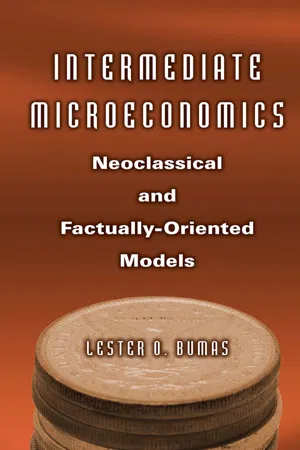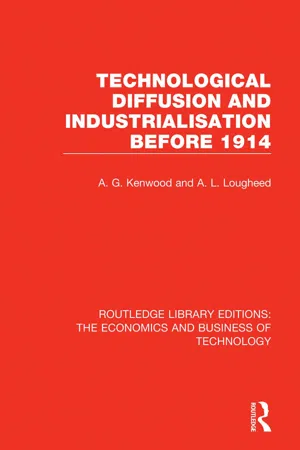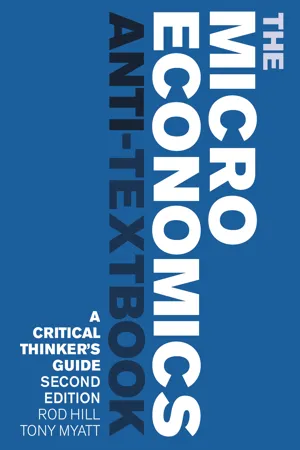Competitive Market
A competitive market is a situation where numerous buyers and sellers interact to trade goods and services at a price determined by market forces. In this environment, no single buyer or seller has the power to influence the market price, and entry and exit are relatively easy. Competition in such markets tends to lead to efficient allocation of resources and lower prices for consumers.
8 Key excerpts on "Competitive Market"
- eBook - ePub
Intermediate Microeconomics
Neoclassical and Factually-oriented Models
- Lester O. Bumas(Author)
- 2015(Publication Date)
- Routledge(Publisher)
...The basic reason for this is the contention that the behavior of prices, profits, and outputs in general corresponds to that described in the neoclassical model of the Competitive Market. Thus, for example, the contention is that an increase in demand for a product will increase its price, rate of production, and the profits of firms in the competitive and all other markets. Moreover, the same claim is made for factor markets such that an increase in the demand for a certain form of labor will increase its price and employment in competitive and all other factor markets. The Competitive Market is also commonly used as the standard against which all other market forms are judged in terms of allocative and production efficiency —essentially producing at the lowest possible short- and long-run price. Agriculture is the economic sector generally considered to be the best example of a competitive product market. Characteristics of the Competitive Model The characteristics of the competitive model follow: Standardized Products The existence of a Competitive Market requires the products of all producers in the market to be the same—to be: standardized or homogeneous, if you prefer. Thus all products in a Competitive Market must be perfect substitute for each other. They should all then have the same price. Were a producer able to differentiate his product from others in the industry, he could have some control over price thus escaping from total domination by the market. The producer of carrots who advertises and markets “The World’s Best Organic Carrots” leaves the market for ordinary carrots by differentiating his. A Large Number of Producers The more producers there are, the lower is the portion of the market supply provided by an individual producer...
- A. G. Kenwood, A. L. Lougheed(Authors)
- 2018(Publication Date)
- Routledge(Publisher)
...12 THE Competitive Market ECONOMY I All societies make choices of what to produce, how, and for whom, by means of various social systems. A market economy is one such system in which the basic economic questions are decided, not by tradition or by some central authority, but by producers and consumers acting in markets in response to changes in the prices of the things they buy and sell. The essence of the system is that goods are produced for exchange and that these exchanges are money transactions. All inputs and all outputs have prices that are set in the market by the actions of a host of competitors, each seeking his own advantage. Simultaneously these prices and their relationships to one another provide the guides for the direction of production into various channels, the selection among alternative production techniques, and the distribution of total output among various persons in society. Given the nature of the functioning of a market society, it was not possible for it to coexist with a form of legal organisation which did not recognise the freedom of the individual to contract for employment as he wished. Nor could it exist without private ownership of property, which conferred on the individual full freedom to use and to transfer property as he chose. Indeed, economic growth requires that men, whether privately or as public officials, have access to resources and are free to buy, borrow or hire factors of production since, if a person may use only his own labour, land and capital, the advantages of specialisation and the economies of large-scale enterprise will not be realised. The organisation of production within such a system also requires a pattern of behaviour consistent with the new market environment imposed on society. This emerged in the form of a widespread drive to maximise one’s income by concluding the best possible bargains in the market...
- eBook - ePub
Wealth, Welfare and the Global Free Market
A Social Audit of Capitalist Economics
- Ibrahim Ozer Ertuna(Author)
- 2016(Publication Date)
- Gower(Publisher)
...There would have to be large number of small buyers and sellers on the market, each of them so small that its actions could have no significant impact on the market prices. In economic terminology, the participants are “price takers.” Goods and services traded on the markets must be identical; that is, there would be no product differentiation. All buyers and sellers would have to have complete information on all relevant facts about the market. There would need be no barrier to entry; that is, all participants would have to have access to products and production technology, plants, and all the means needed. So any participant of the market may enter or exit at their free will. There would have to be full mobility of resources. All buyers and sellers would have to act independently in seeking their own interest: there would be no collusion or no cartels. The prevailing economic theory is constructed on these hypothetical assumptions and the conclusions of the theory are relevant only under these assumptions. Under these assumptions, the prices determined in the markets will guide the economy in the interest of the public at large. 1 Perfect competition is an economic model that describes a hypothetical market form in which no producer or consumer has the market power to influence prices. Perfect competition would lead to a completely efficient outcome. Perfect competition leads to a market equilibrium in which all resources are allocated and used efficiently to serve the interest of the society. Demand Theory in Economic Science Demand theory studies the factors affecting the demand of buyers, and how these factors influence demand. In its study, economic theory benefits from the models it develops, again under some assumptions. Using these models, economic theory tries to reach some conclusions. Economics assumes that people consume in order to increase their utility. This is the basic assumption of the economic theory of demand...
- eBook - ePub
- Keith Porter, Paul Smith, Roger Fagg(Authors)
- 2007(Publication Date)
- Routledge(Publisher)
...unsafe goods, recreational drugs) and itself providing some goods and services (e.g. education), by taxes and subsidies, and by nationalization. Macroeconomic problems such as unemployment and inflation, as well as exchange rates, etc. The worth (or otherwise) of the various combinations of market and government provision depend on the nation's economic objectives (such as economic growth, efficiency in production and full employment) and political goals (liberty, equality, etc.). Perfect competition It is important to realize that in this context the word ‘perfect’ does not mean ‘best’. It refers to the idea of ‘total’ competition, in that there is a total absence of market power, entry barriers and product differentiation, plus total information for producers and consumers in the market. Economists study highly Competitive Markets because the model provides an approximation of how the real world works and gives a useful insight into the workings of the market economy. Both producers and consumers are price takers. This means that they have to accept the prices set by market forces. This is very close to reality for consumers, because there are few occasions on which we can haggle about the prices of products. For producers, perfect competition means that firms are too small and have to compete with too many other firms to be able to raise prices. This is the case for some producers in some markets, but in many cases firms do have the power to determine prices (although they do have to take into account consumer demand in doing this). A problem of trying to classify economic systems is that countries also differ in the type of government intervention as well as the level (see Figure 9.1)...
- eBook - ePub
Environmental and Natural Resources Economics
Theory, Policy, and the Sustainable Society
- Steven Hackett, Sahan T. M. Dissanayake(Authors)
- 2014(Publication Date)
- Routledge(Publisher)
...For a market to be well functioning and competitive, there must be many individual buyers and sellers, each of whom is small relative to the overall market. Market entry and exit costs must be inconsequential. Current and potential market participants must be fully informed of prices, qualities, and location; transaction costs must be low. There must be no collusion among the market participants. There can be no consequential positive or negative externalities. When any of the above conditions is substantially absent, a market failure has occurred, meaning that the market no longer meets the conditions for being well functioning and competitive. Economists argue that market failures are a central justification for public policy intervention in market capitalist systems if these interventions are designed to correct for the market imperfections and the interventions do not create a larger distortion than the market failure itself. Consumer demand can be derived from the level of the buyers’ utility over various alternative products, their budget constraints, and product prices. Horizontally summing the quantity demanded by all consumers at a given market price results in the market demand curve. In a well-functioning Competitive Market, a firm’s short-run supply curve is equal to its marginal cost curve. Horizontally summing the quantity supplied by all sellers at a given market price results in the market supply curve. We discussed the theoretical requirements for efficient markets to be in equilibrium, namely that the quantity supplied by sellers equals the quantity demanded by buyers at the prevailing price, so there is neither excess demand nor excess supply. Total surplus is the total gain from voluntary market exchange...
- eBook - ePub
The Microeconomics Anti-Textbook
A Critical Thinker's Guide - second edition
- Rod Hill, Tony Myatt(Authors)
- 2021(Publication Date)
- Zed Books(Publisher)
...Chapter 3 How markets work (in an imaginary world) 1 The standard text 1.1 What is a Competitive Market? There is no ‘competing’ behaviour in a Competitive Market – no advertising, no price-setting strategies, no rivalry. This is because all buyers and sellers are price-takers. This requires large numbers of buyers and sellers, with no one buyer or seller having a significant market share, and all firms producing an identical (or homogeneous) good or service. 1.2 The demand curve An individual’s demand curve describes the relationship between the quantity demanded and the good’s own price ceteris paribus (holding all other influences constant). These other influences include the individual’s preferences, income and the prices of related consumption goods. These may be either complements (such as DVDs and DVD players) or substitutes (such as chicken or beef). Expected future prices may also be important in determining how much is bought currently. An individual’s demand curve is a frontier – it tells us the maximum price he or she is willing to pay to obtain any given quantity. If any of the other influences change, the demand curve shifts. To obtain the market demand, we sum the amounts every individual wishes to buy at any given price. Thus the size of the population influences demand. The shape of the market demand curve shows the responsiveness of quantity demanded to price changes. Normally, as the price increases, quantity demanded decreases, as seen in Figure 3.1. Figure 3.1 Inelastic and elastic demand The responsiveness of quantity demanded to a change in price is measured by the price elasticity of demand. It is defined as: Suppose a 50 per cent increase in the price of gasoline leads to a 10 per cent decrease in the quantity demanded. The price elasticity of demand for gasoline is 0.2 (10 per cent divided by 50 per cent)...
- eBook - ePub
- Israel M. Kirzner(Author)
- 2015(Publication Date)
- University of Chicago Press(Publisher)
...This process of bringing the plans of market participants into dovetailing patterns is, as we have seen, competitive. No one producer—in his role of entrepreneur—can ignore the possibility that a profit opportunity may be grabbed by another entrepreneur. After all, an entrepreneur needs no assets to engage in profitable market participation. A producer need not own any resources in order to engage in production; he merely has to know where to buy resources at a price that will make it worthwhile to produce and sell the product at its attainable price. Since, then, anyone can, at least in principle, be a producer (since no special natural or other endowment is necessary), the market process, which is channeled through the activities of the producers, is competitive. The question then arises, What are economists referring to when they talk of “monopolistic markets”? And, in particular, What is to be understood by the term “monopolistic producer”? Have we not seen that producers are entrepreneurs who can never be immune from the forces of competition? MONOPOLY AND THE MARKET PROCESS Perhaps the central purpose of this book is to offer a satisfactory answer to the questions just posed, while adhering consistently to the framework of discussion which raised these questions in the first place. This framework has, first of all, identified the market process in general as a competitive one (in the sense that it proceeds by the successive efforts of profit-seeking entrepreneurs to outstrip one another in providing attractive buying and selling opportunities to the market). Further, we have emphasized the entrepreneurial role filled by the producer, so that the productive efforts of producers turned out to be of the very same pattern as the competitive activities of entrepreneurs in general...
- eBook - ePub
Experimental Economics
Volume II: Economic Applications
- Pablo Branas-Garza, Antonio Cabrales, Pablo Branas-Garza, Antonio Cabrales(Authors)
- 2016(Publication Date)
- Palgrave Macmillan(Publisher)
...2 Non-Competitive Markets Nikolaos Georgantzís and Giuseppe Attanasi Introduction A market is not competitive when the agents acting in such a market have the power to influence the price, directly or indirectly, something that does not occur under perfect competition. Generally, these agents have market power because they are few in number, have access to relevant information and can foresee the interdependence between their strategies and those of others. Among all the paradigms in economic theory, the theoretical predictions of oligopoly were the first to be examined in the laboratory. In the origins of experimental economics one can find the works of Chamberlin (1948) and of Smith (1962, 1964), who designed experiments to study a market with few agents that could reach the competitive equilibrium (see Chapters 1). In this chapter, instead of surveying all experiments with few sellers, 1 we will adopt a narrower definition of the term “oligopoly,” and will focus on experiments that were directly inspired by the basic oligopolistic models of Cournot (1838), Bertrand (1883), Hotelling (1929), von Stackelberg (1934), and similar. We will omit, therefore, other experiments, such as those of Chamberlin and Smith, which were designed with the aim of testing the predictive power of the competitive equilibrium model. Most of the experiments we consider in this chapter have been run in the last three decades. 2 This literature can be considered as a new wave of experimental work, aiming at representing basic oligopolistic markets and testing their properties. This work represents a systematic attempt to study a similar, but not identical, question to that tackled by Chamberlin (1948) and Smith (1962, 1964)...







